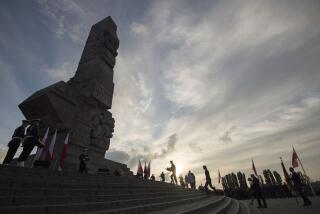Pope Consecrates 7,000-Seat Cathedral, Poland’s Biggest
- Share via
LICHEN, Poland — In this remote lakeside hamlet, Pope John Paul II consecrated Poland’s biggest church Monday and proclaimed Our Lady of Sorrows Basilica an inspiring tribute to fellow Poles’ enduring faith after decades of Nazi and Communist repression.
The massive cathedral, modeled after St. Peter’s in Vatican City and eye-catching from miles away across a wheat-sprouting plain, is the project of a local pastor who took to heart the pope’s call on a previous visit for a fitting monument here to the Virgin Mary.
Lichen is a hallowed place of pilgrimage for 1.5 million Roman Catholics each year, and the new cathedral built to celebrate the 2000 jubilee of Christianity will be capable of holding 17,000 worshipers--7,000 seated--when it is completed sometime early in the next millennium.
“I look with admiration upon this large building, which in its architectural richness is an expression of faith and love for Mary and her son,” the pontiff told a cheering crowd of 250,000 whose songs and spirits were not dampened by a steady downpour.
Many of the pilgrims had come to Lichen by foot the previous day from campgrounds and farmhouses dozens of miles away. They were equipped with ponchos and plastic sheeting to brave the spring elements as they stood overnight vigil for a glimpse of the 79-year-old pontiff who many fear may be making his last visit home.
But speaking more clearly and moving with more vigor than he has been seen to do in a couple of years, John Paul bestowed the church’s blessings on the basilica and thanked the pilgrims for their generosity in funding “this important undertaking.”
In the heart of the Polish countryside, still struggling to wrest itself from communism’s economic ruin, the cathedral is hailed by many as testimony to Poles’ religious rebirth since the fall of atheistic rule but is railed against by others as an expenditure of gothic proportions by the poor.
Patrons of the project spearheaded by 71-year-old Father Eugeniusz Mikulski note that the work begun a decade ago has provided 400 construction jobs in a parish of 3,000 inhabitants who have mostly been unemployed since their state farms foundered in the new market environment. The cathedral also is providing a boost to the bed-and-breakfast trade making its way into many homes within trekking distance of the looming structure.
Mikulski demurs when asked the cost of his structure, the seventh-largest church in all of Europe, deeming it “God’s work” and the expression of the will of the pilgrims. But independent analysts say the church, faced with ocher marble and lighted by gilded amber windows, has already cost $50 million and is still several years from completion. The domed basilica that rises 30 stories was designed by architect Barbara Bielecka to evoke the colors and shapes of the surrounding wheat fields.
The world’s largest church, surpassing even St. Peter’s, is the Basilica of Our Lady of Peace in the West African nation of Ivory Coast, consecrated by John Paul in 1990. Built by Ivory Coast’s late President Felix Houphouet-Boigny at a cost of about $150 million, and in a similarly remote location, it too has been criticized for its splendor in the midst of dire poverty.
While political commentators and struggling jobless lament the cost of Our Lady of Sorrows, the millions who have visited Lichen and supported the project with modest donations take pride in the outsize achievement.
“This is the first time I’ve seen the basilica, and it’s absolutely wonderful,” said Andrzej Matusiak of Lublin, a 51-year-old father of seven on a disability pension who has nonetheless made regular contributions to the cathedral fund drive. “For me, it is like having the Vatican in Poland.”
Jadwiga Lorent left her home in a nearby village at 3 a.m. to reach the site of the pope’s ceremony of blessing. Like the Matusiak family, she has sent small offerings to Mikulski’s cathedral fund in homage to the Virgin Mary, whom she credits with curing her of illness.
Lichen became a place of pilgrimage 150 years ago when a small church was built here to house a shrine to the Virgin Mary around a painting said to depict her in an 1813 apparition before a wounded Polish soldier in the Napoleonic Wars.
Faith that endures through suffering and hardship has been a prominent theme of the pope’s seventh visit to his homeland, which began Saturday. After the Lichen consecration, John Paul visited the grave of Father Jerzy Popieluszko, a pro-democracy advocate kidnapped and killed by Communist secret service agents in 1984.
In Warsaw on Friday, after a short rest at a monastery in the northeastern retreat of Wigry, the pontiff is scheduled to beatify 108 martyrs of the Holocaust and of post-World War II Siberian exile.
After consecrating the cathedral and saying prayers over Popieluszko’s grave in Bydgoszcz, John Paul met with rectors and professors of the Nicholas Copernicus University in Torun to expound on the ancient debate between “truth and reason”--the tenets of the Christian faithful and the often conflicting principles of science.
He made no direct criticism of research endeavors opposed by the church, such as cloning, but warned that technology should not be allowed to overtake morality.
“The unprecedented development of the sciences and technological progress are raising fundamental questions about the limits of experimentation, the meaning and direction of technological development, the limits of man’s tampering with nature and the natural environment,” the pope said before offering prayers at Torun airport. “This progress gives rise to both wonderment and fear.”
More to Read
Sign up for Essential California
The most important California stories and recommendations in your inbox every morning.
You may occasionally receive promotional content from the Los Angeles Times.














